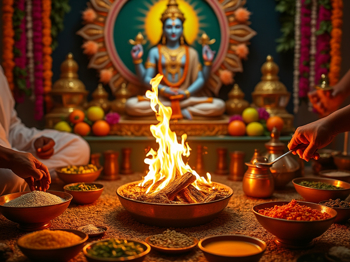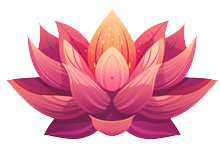The significance of Ayush Homam Puja lies in its power to invoke the divine energies that promote good health and long life. This ritual is believed to cleanse the body and mind, remove obstacles, and eliminate any negative energies or influences that might shorten one's lifespan. By performing this puja, devotees seek the grace of Ayur Devata to ensure a disease-free, prosperous, and happy life.
The Ayush Homam Puja is a Vedic ritual dedicated to enhancing longevity, health, and overall well-being. It is typically performed for children when they turn one year old but can be done for individuals of any age, especially during times of health concerns. The puja invokes blessings from Lord Ayurdevata, the deity of life and longevity, and other Vedic deities like the Navagrahas (nine planets). Here are the key benefits of performing Ayush Homam Puja:
1. Enhances Longevity
- Primary Purpose: The main objective of the Ayush Homam is to pray for long life. It is believed that by performing this ritual, one can seek the blessings of Ayurdevata to increase lifespan.
- Averts Untimely Death: The puja is especially recommended if someone has experienced a serious illness or health issues, with the aim of preventing untimely death.
2. Promotes Good Health
- Healing Power: This puja is believed to remove health obstacles and promote overall well-being. It is particularly beneficial for children and those recovering from illnesses.
- Cleanses Negativity: Ayush Homam purifies the body and mind by dispelling negative energies, diseases, and malefic planetary effects (Doshas).
3. Removes Negative Planetary Effects
- Navagraha Blessings: The puja also invokes the blessings of the nine planets, which helps in mitigating the adverse effects of planetary doshas (astrological issues) that may cause health problems or life disruptions.
4. Improves Mental and Emotional Well-Being
- Balancing Mind and Body: In addition to physical health, Ayush Homam is known to bring mental clarity, peace, and emotional stability by balancing the energies of the body and mind.
- Prevents Anxiety and Stress: Performing the ritual can relieve anxiety, stress, and other mental health concerns, improving overall emotional balance.
5. Offers Protection and Spiritual Blessings
- Divine Protection: Ayush Homam provides protection from accidents, mishaps, and evil energies. It helps individuals remain spiritually protected and focused on the path of Dharma (righteousness).
- Blessings for the Whole Family: The ritual is not only for the individual but also for the entire family, invoking prosperity, harmony, and positive energy in the household.
6. Ideal for Special Occasions
- Performed on Birthdays: Traditionally, the Ayush Homam is performed on the first birthday of a child, but it is also performed annually or during critical times for continued health and protection.
- For Milestones: It can also be done on significant birthdays (like 60th or 80th birthdays) as a way of celebrating life and seeking the deities' continued blessings for future years.
7. Restores Balance of the Five Elements
- Environmental and Body Cleansing: The sacred fire in the Homam is believed to balance the Pancha Bhutas (five elements—earth, water, fire, air, and ether), which constitute the human body and the universe. This balance promotes health and well-being.
8. Relieves Karma and Ancestral Curses
- Cleanses Past Karmas: The ritual helps in cleansing negative past karma and reduces the effect of any ancestral curses (Pitru Dosha) that may be affecting one's health or longevity.
9. Improves Focus and Success in Life
- Clarity in Life’s Purpose: By enhancing mental clarity and emotional stability, the puja helps individuals stay focused on their goals, leading to greater success in personal and professional endeavors.
10. Strengthens the Immune System
- Holistic Wellness: The offerings to the fire and recitation of mantras have a healing effect that is said to enhance the body's immune system and vitality, reducing vulnerability to diseases and ailments.
Conclusion:
Performing the Ayush Homam Puja offers profound spiritual, physical, and emotional benefits. It is a Vedic ritual that focuses on longevity, health, and protection from negative influences while fostering peace, harmony, and overall well-being for individuals and their families.
Performing an Ayush Homam Puja is a traditional Hindu ritual aimed at invoking the blessings of the gods for longevity, health, and prosperity, typically performed on a child's first birthday or during the first year to ensure long life and ward off any negative influences. Below is a step-by-step guide to performing this ritual.
1. Preparation
- Choose a Date: Consult a priest (Pandit) to select an auspicious date and time (Muhurat) for the Ayush Homam Puja.
- Cleanse the House: Clean the house thoroughly, especially the area where the puja will be performed. Decorate the space with rangoli, flowers, and light lamps.
- Arrange the Puja Items: Gather all the necessary items:
- Kalash (water vessel)
- Coconut
- Mango leaves
- Turmeric and vermilion (kumkum)
- Flowers
- Rice
- Sandalwood paste
- Fruits and sweets
- Ghee (clarified butter)
- Sacred thread (Yagnopavita)
- Homam Kund (fire pit)
- Samagri for the Homam (wood, dried cow dung cakes, herbs, etc.)
- Aasan (seat) for the priest and family members
- Idols or images of deities (Lord Vishnu, Lord Ganesha, etc.)
- Paan Supari (betel leaves and nuts)
- Incense sticks, camphor, and a bell
2. Inviting the Priest
- Invite a Qualified Priest: The ritual requires a knowledgeable priest (Pandit) to conduct the puja, as specific mantras need to be chanted accurately.
3. Sankalp (Vow)
- Purification: The priest will begin by purifying the space with holy water and chanting specific mantras.
- Taking Sankalp: The parents (or the person for whom the puja is performed) take a vow (Sankalp) in front of the deities, stating their intention for the puja. They will hold some rice, flowers, and a little water in their hands, which they will later release into the fire or at the feet of the deity.
4. Ganapati Puja
- Invoke Lord Ganesha: The priest will invoke Lord Ganesha, the remover of obstacles, to ensure the puja proceeds without hindrance. Offerings of flowers, fruits, and sweets are made while chanting Ganesha mantras.
5. Kalash Sthapana (Establishing the Sacred Pot)
- Setup Kalash: The Kalash is filled with water, topped with a coconut, and surrounded by mango leaves. It symbolizes the presence of the divine.
- Invocation: The priest invokes the presence of various deities into the Kalash through mantras.
6. Ayushya Mantra Recitation
- Chanting of Ayushya Suktam: The priest recites the Ayushya Suktam from the Rigveda, which is a set of mantras dedicated to longevity and good health.
- Offerings: During the chanting, offerings of ghee, herbs, and wood are made into the fire.
7. Homam (Fire Ritual)
- Lighting the Fire: The fire (Agni) is lit in the Homam Kund.
- Offering to Fire: The priest, with the help of family members, makes offerings (Ahuti) into the fire while reciting specific mantras.
- 108 Names of Ayushya Deva: Chant the 108 names of Ayushya Deva and offer ghee and samagri into the fire.
8. Purnahuti (Final Offering)
- Final Offerings: The final offering (Purnahuti) is made to the fire, symbolizing the completion of the Homam.
- Aarti: An Aarti (lighting of camphor and waving it before the deities) is performed while chanting the closing prayers.
9. Prasadam Distribution
- Distribution of Prasad: The offerings (Prasadam) made during the puja are distributed among the attendees. This includes fruits, sweets, and any food items prepared for the occasion.
10. Blessings
- Blessing the Child: The child for whom the puja is performed receives blessings from the priest, elders, and all attendees. The child is made to touch the feet of the priest and elders, who then bless them with longevity and good health.
11. Conclusion
- Thanksgiving: A final prayer of gratitude is offered to the deities, and the puja area is cleaned up.
- Dakshina: Offer dakshina (monetary offering) to the priest, thanking him for conducting the puja.
12. Post-Puja Rituals
- Annadanam: In many traditions, it's customary to perform Annadanam (feeding the poor or guests) as part of the puja.
- Home Cleansing: The puja space is cleaned, and the family members may take a ritual bath to conclude the ceremony.
This detailed process helps ensure that the Ayush Homam Puja is conducted in a traditional and respectful manner, invoking the blessings of the divine for a long and healthy life.




